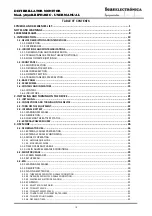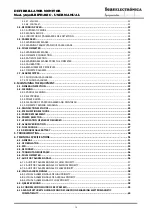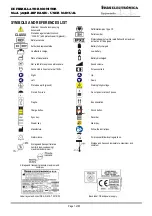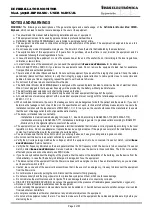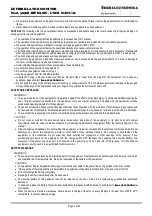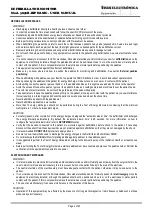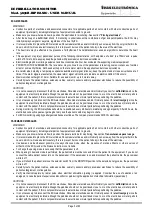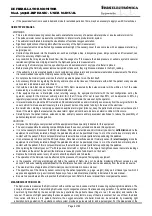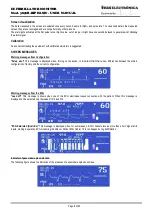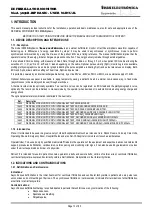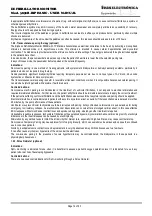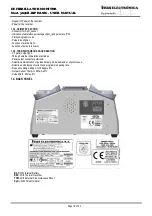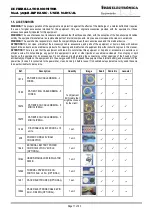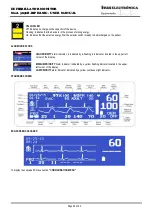
DEFIBRILLATOR MONITOR
Mod. 3850B-BIPHASIC - USER MANUAL
Page 5 of 63
ECG MESSAGES
WARNINGS
•
Conductive parts of electrodes and associated connectors for applicable parts shall not contact with other conductive parts of
equipment (metal part), including metal parts of equipment connected to ground.
•
Make sure you know where and how to position the electrodes for monitoring. See section “Placing electrodes”.
•
After the delivery of a defibrillator shock, if monitoring is undertaken with a combination of gel and patch/paddle, the ECG may
initially display no signal or asystole, regardless of the true rhythm.
•
It is recommended to place the ECG electrodes, Pacemaker electrodes and/or Oximetry sensor away from the surgical field in the
case in which it will use an electrocautery; this is to prevent burns on the patient’s body in the area of the electrode.
•
The heart rate may be affected in the presence of arrhythmias. The cardiotachometer uses an algorithm to determine the heart
rate.
•
This equipment may reject pacemaker pulses of the following characteristics: with amplitude of ±2mV to ±700mV and a pulse
width of 0.1ms to 2ms, anyway keep the patients with pacemaker under close surveillance.
•
Electrocardiographic monitoring equipment and its accessories shall not be considered life-supporting medical equipment.
•
PATIENTS WITH PACEMAKERS. The rate meter may continue to count the pacemaker rate during some occurrences of cardiac
arrest or some arrhythmias. Not based entirely on the rate meter alarms. Keep patients under close surveillance.
•
Be careful when making a temporary suspension audible alarm signal (silence), keep the patient under close surveillance at all
times. If the alarm signals are selected, the visual alarm signal will continue to indicate an alarm condition if this occurs.
•
Maximum channel height: 21.2mm. Suitable for use as a monitor up to 2 meters away.
•
Carefully route the patient cables, extension cables, oximetry sensors and/or pacemaker electrodes to reduce the possibility of
patient entanglement or strangulation.
CAUTIONS
•
It is not necessary to disconnect the ECG electrodes, Pacemaker electrodes and/or Oximetry sensor for defibrillation since the
equipment is electrically isolated; although the paddles should not be positioned close to or on the electrodes or metal parts in
contact with the patient, if this is not possible remove the electrodes or metal parts before positioning the paddles.
•
It is not necessary to disconnect the ECG electrodes, Pacemaker electrodes and/or Oximetry sensor for electrosurgery since the
equipment is electrically isolated; although the paddles should not be positioned close to or on the electrodes or metal parts in
contact with the patient, if this is not possible remove the electrodes or metal parts before positioning the paddles.
•
During monitoring, the ECG electrodes should be re-positioned every 48 hours to maintain good signal quality. After 48 hours, the
electrode’s conductive paste or gel begins to dry and the patient’s skin may begin to chafe.
•
For ECG monitoring using hypoallergenic adhesive electrodes. The company recommends 3M ECG electrodes.
PACEMAKER MESSAGES
WARNINGS
•
Conductive parts of electrodes and associated connectors for applicable parts shall not contact with other conductive parts of
equipment (metal part), including metal parts of equipment connected to ground.
•
Make sure you know where and how to position the pacer electrode for monitoring. See section Transcutaneous pacer usage.
•
It is recommended to place the ECG electrodes, Pacemaker electrodes and/or Oximetry sensor away from the surgical field in the
case in which it will use an electrocautery; this is to prevent burns on the patient’s body in the area of the electrode.
•
Use demand mode whenever possible. Use asynchronous mode when the presence of motion artifacts or other sources of
artifacts, of the ECG, render the R-wave detection is not reliable.
•
To change the pacing mode is necessary that the pacemaker is off.
•
When pacing in demand mode is performed, the patient cable must be connected from the patient to the equipment. If you do not
connect the cable patient cannot turn on the pacemaker. If the pacemaker is on and disconnect the patient cable, the pacemaker
will turn off.
•
If you will shock the patient, at move the selector switch from the MONITOR position to the selected energy value, the pacemaker
will turn off.
•
Carefully route the patient cables, extension cables, oximetry sensors and/or pacemaker electrodes to reduce the possibility of
patient entanglement or strangulation.
•
Verify mechanical capture by radial pulse when electrical stimulation (pacing) is applied. Consider the use of sedation or an
analgesic, in case the patient experiences discomfort or pain during the application of electrical stimulation (pacemaker).
CAUTIONS
•
It is not necessary to disconnect the ECG electrodes, Pacemaker electrodes and/or Oximetry sensor for defibrillation since the
equipment is electrically isolated; although the paddles should not be positioned close to or on the electrodes or metal parts in
contact with the patient, if this is not possible remove the electrodes or metal parts before positioning the paddles.
•
It is not necessary to disconnect the ECG electrodes, Pacemaker electrodes and/or Oximetry sensor for electrosurgery since the
equipment is electrically isolated; although the paddles should not be positioned close to or on the electrodes or metal parts in
contact with the patient, if this is not possible remove the electrodes or metal parts before positioning the paddles.





